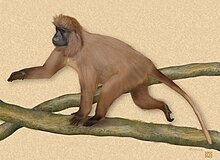Highland mangabey
| Kipunji | |
|---|---|
 |
|
| Scientific classification | |
| Kingdom: | Animalia |
| Phylum: | Chordata |
| Class: | Mammalia |
| Order: | Primates |
| Family: | Cercopithecidae |
| Subfamily: | Cercopithecinae |
| Tribe: | Papionini |
| Genus: |
Rungwecebus Davenport, 2006 |
| Species: | R. kipunji |
| Binomial name | |
|
Rungwecebus kipunji (Jones et al., 2005) |
|
 |
|
| Kipunji range | |
The kipunji (Rungwecebus kipunji), also known as the highland mangabey, is a species of Old World monkey that lives in the highland forests of Tanzania. The kipunji has a unique call, described as a 'honk-bark', which distinguishes it from its close relatives, the grey-cheeked mangabey and the black crested mangabey, whose calls are described as 'whoop-gobbles'. Though it was originally thought to be a member of the Lophocebus genus genetic data later placed it as its own separate genus Rungwecebus. The kipunji is the first new monkey genus to be discovered since Allen's swamp monkey in 1923.
The kipunji was independently discovered by researchers from the Wildlife Conservation Society, the University of Georgia and Conservation International, in December 2003 and July 2004, making it the first new African monkey species discovered since the sun-tailed monkey in 1984. Originally assigned to the genus Lophocebus, genetic and morphological tests showed that it is more closely related to the baboons (genus Papio) than to the other mangabeys in the genus Lophocebus, and that Lophocebus was diphyletic, meaning that species with differing genealogies have been mistakenly lumped together. Scientists have assigned it to a new genus, Rungwecebus, named after Mount Rungwe, where it is found.
Adult male kipunji have been observed at an average length of 85 to 90 cm and are estimated to weigh between 10 and 16 kg. The kipunji's relatively long pelage is light or medium brown with white on the end of the tail and the ventrum. Pelage close to the hands and feet tends to be a medium to dark brown. Hands, feet, and face are all black. These primates do not appear to show any sexual dimorphism in relation to pelage coloration.
...
Wikipedia

